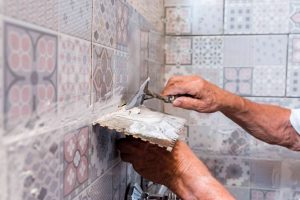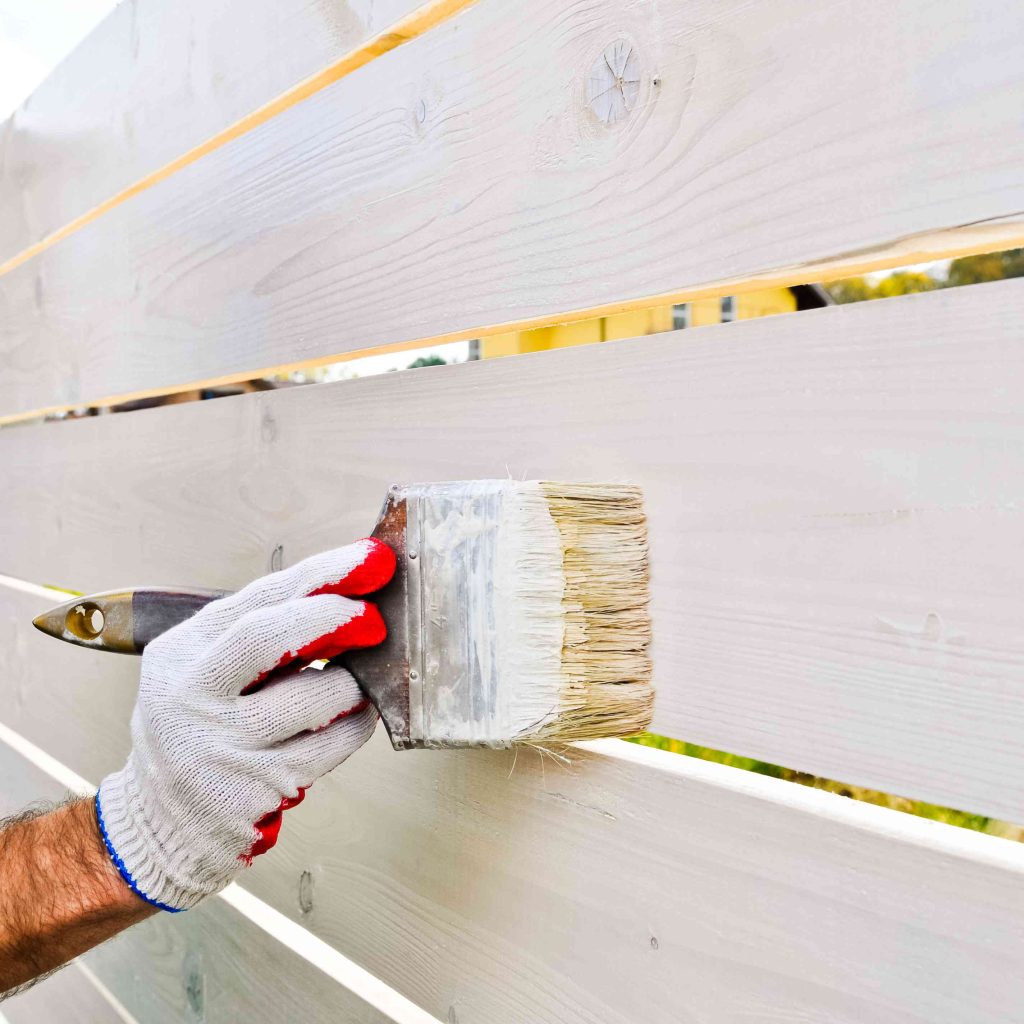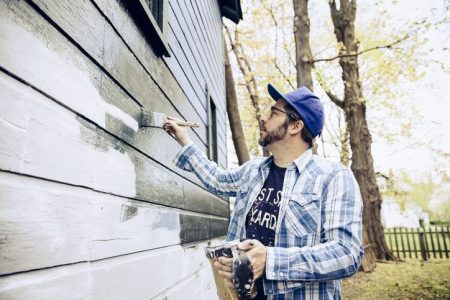With pressure-treated wood, a protective copper azole liquid compound is injected into the wood under high pressure in a factory.Over time, the copper treatment can lose its effectiveness. Pressure-treated wood, too, has a uniform brown color, and its surface is pocked with injection holes.
Painting pressure-treated wood with exterior-grade paint improves its appearance and preserves the wood for as long as the paint remains in good condition.
Prepare Pressure-Treated Wood for Painting
Older, dirty pressure-treated wood will need to be cleaned. Areas closer to the ground get dirtier due to splashing. Shaded sections may develop mold and moss.
- Clean the wood: Use a nylon-bristle brush and an oxygenated cleaner or deck brightener to remove dirt, mold, and mildew from the surface of the pressure-treated wood.
- Patch the wood: Patch large cracks in pressure-treated wood with epoxy resin. Use a two-part epoxy wood consolidant before applying the epoxy resin.
Test Pressure-Treated Wood for Moisture
Painting over pressure-treated wood with a high moisture content can cause the paint to peel, crack, blister, or change color. To avoid these issues, test the wood for moisture content.
- Test external dryness: Sprinkle a few drops of water on the surface of the wood. If the water quickly soaks in, the surface is dry enough to be painted.
- Test internal dryness: Aim for moisture levels of 15-percent or less. If the pressure-treated wood is used inside, it should be around 12-percent or less. Pinless moisture meters calculate internal moisture content with an electromagnetic sensor. Pin-style meters require tiny holes drilled in the wood and can be rented or purchased for $75 to $175.
What You’ll Need
Equipment / Tools
- Paint roller
- Roller cover with 3/8-inch nap
- Brush
- 5-gallon bucket
- Roller screen
- Putty knife
- Brush with nylon bristles
- Moisture meter
Materials
- Exterior primer
- Exterior paint
- Two-part moldable epoxy resin kit (optional)
- Two-part epoxy wood consolidant
- Oxygenated cleaner
Instructions
Painting Pressure-Treated Wood
-
Brush Primer in Difficult Areas
Use the brush to prime narrow, recessed, or high areas the paint roller will not reach.
-
Roll Primer on Large Areas
Use the paint roller to prime for large and flat sections of pressure-treated wood. Paint by first dipping the roller cover in the primer, then rolling it out on the screen. Roll in small sections of about 4 feet by 4 feet. Take your time and work slowly.
-
Brush Paint on Wood
Let the primer dry for 30 to 60 minutes. Clean out the paint bucket and roller screen. Add paint to the bucket and stir thoroughly. As with the primer, use the brush to address areas that the roller will not fully reach such as tight corners.
-
Roll Paint on Wood
Use the paint roller with a fresh roller cover to paint the wood. Apply one coat, then allow it to dry. Paint recoat waiting times can be as little as a half-hour for flat paint and up to three hours or even more for a glossy paint. Apply the second coat when dry.
How to Choose an Exterior Paint Color
Alternative to Painting Pressure-Treated Wood
One alternative to painting is to order color-tinted pressure-treated wood. Usually available in wood tones such as redwood, walnut, or cedar, color-tinting gives the wood deep color and protection that lasts longer than a paint coating.
When to Call a Professional
Small-scale painting projects are manageable by most do-it-yourselfers. But large-scale projects, such as painting a deck or fence, may require the assistance of a professional painting company.
-
How long should you wait to paint new pressure-treated wood?
Pressure-treated wood should be completely dry before it is painted, and that could take three to four months. Test the wood for both external and internal moisture before you paint it.
-
Is it better to stain or paint pressure-treated wood?
Staining pressure-treated wood is easier than applying paint. Stain grabs onto pressure-treated wood better, while the paint is a little more difficult to adhere, often resulting in peeling if the wood is not fully dry or ready for painting.
-
Is it OK to sand pressure-treated wood?
You can sand pressure-treated wood, but it is not recommended. Since wood is chemically treated, sanding those chemicals can affect your health and the environment. Also, not all pressure-treated wood is the same, so it can look very inconsistent after sanding.
-
Does pressure-treated wood turn gray?
Pressure-treated wood will eventually turn gray with time, sun, and weathering. To preserve the wood, apply stain, paint, or sealant.
-
What kind of paint will stick to pressure-treated wood?
The best paint for pressure-treated wood is a water-based high quality, exterior latex paint. This is what you should use on both structures and furniture. Avoid oil-based paints!
-
How long does painted pressure-treated wood last?
Painted pressure-treated wood will last as long as the paint. Depending on conditions, exterior paint can last five to ten years before it needs re-application. Painting pressure-treated wood before it is sufficiently dry will cause the paint to prematurely fail.
Read the full article here














